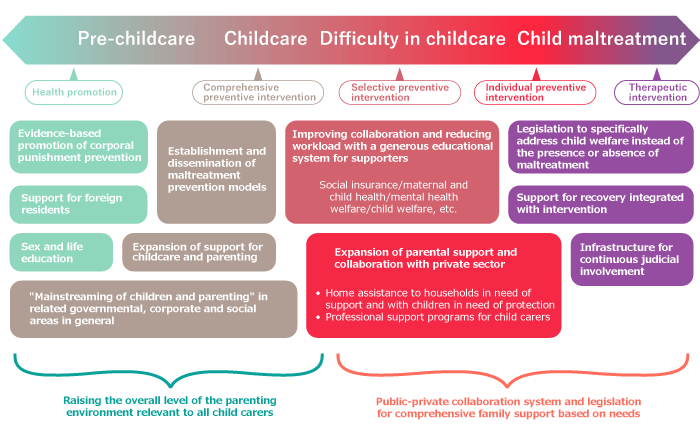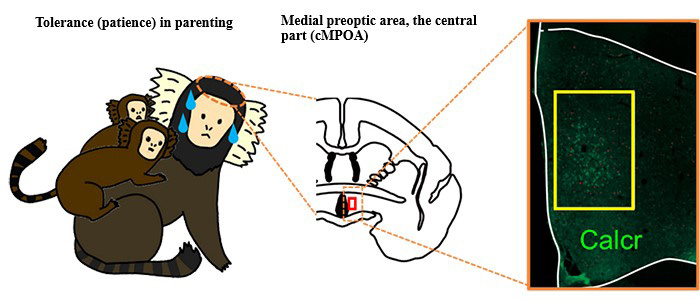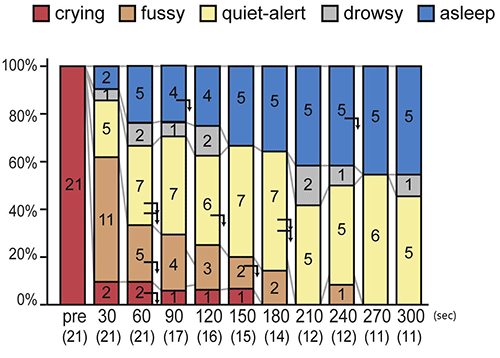Research Results
Considering the declining birthrate and child maltreatment measures from the viewpoint of brain function
Parent-child connection revealed by brain scienceFY2023

- KURODA Kumi(Team Leader, Laboratory for Affiliative Social Behavior, RIKEN Center for Brain Science)
- RISTEX
R&D Program, "Science of Science, Technology and Innovation Policy" - Principal Investigator (2018-2022), "Biology-informed, family-friendly policies against declining birth rate in Japan"
Contributing to effective countermeasures against the declining birthrate with science and technology
The project led by Dr. Kuroda, Team Leader of RIKEN, assumed that one of the reasons why Japan's policies for the declining birthrate have not always been effective is that the bioscientific and behavioral findings on parenting and child development have not been sufficiently referenced in the policy-making process, and that actual policies have been drafted and implemented with no scientific basis.
Dr. Kuroda and her team members, who specialize in brain neural circuits controlling parenting and children's attachment to their parents, have analyzed the factors that make parenting difficult in the project, "Research and policy of parental support systems to prevent child maltreatment" in the R&D area of RISTEX, "Creating a Safe and Secure Living Environment in the Changing Public and Private Spheres". The project proposed appropriate forms of support and frameworks for each of these factors (Fig. 1).
The project also identified brain regions necessary for primates (apes) to be tolerant in parenting. Its discovery of science-based tips for stopping babies from crying and putting them to sleep has become a major topic in the media (Fig. 2).

Fig. 1 Step-by-step proposals to promote support for child carers
This proposal aims to identify what is needed to provide needs-based support to child carers facing difficulties, and to implement support measures in accordance with the degree of the difficulties in childcare.

Fig. 2 Scientifically identified tips for stopping babies from crying and putting them to sleep
The project has found that babies stop crying and about half of the babies fall asleep when their mothers carry them in their arms and walk around for five minutes in a row.
Intricately overlapping problems between parents and children
Two key words are important when discussing the issues surrounding children in Japan. They are the "declining birthrate", and "maltreatment". Both of these issues are based on the difficulties of parenting. It is only an illusion that parents and children have a prior strong bond based on deep affection. There are also problems impossible to solve by love alone.
A problem of a child is also a problem of the relationship between a parent and a child. The relationship between a parent and a child can be difficult due to the combination of multiple circumstances such as their personalities, their mental/physical health conditions, and their financial situations. The team hoped to solve such problems by studying the relationship between parents and children from the viewpoint of the brain.
The team had already started focusing on specific neurons in the central part of the medial preoptic area, (cMPOA)*1 in the basal forebrain as an important brain region for parenting. Experiments with mice had shown that the suppression of the function of this brain region causes even mother mice with parenting experience to attack their own babies instead of parenting them.
However, the brain activity of children connected to the relationship between parents and children is largely unknown. The brain regions responsible for children to show attachment to their parents by actions such as crying and following their parents have not been fully identified even by the latest brain science. Situations, where a child keeps crying and does not fall asleep, can be stressful for a parent and, in rare cases, can lead to maltreatment. Nevertheless, effective ways to stop babies from crying and help them fall asleep have not been well established.
*1 The central part of Medial Preoptic Area (cMPOA)
The cMPOA is a small region in the preoptic area in the basal forebrain, anterior to the hypothalamus. Inhibiting the function of this region will result in a specific inability to parent children. The same region exists in apes as well as in mice.
Revealing factors in maltreatment and brain functions related to parenting
First, in the approach to countermeasures against abuse, as a case study of difficult child-rearing cases, a detailed questionnaire survey was conducted on men and women caregivers who were in prison for child abuse and on caregivers in general, including their upbringing history, living environment at the time of child-rearing, and caregiver stress. The presence or absence of three factors that often lead to abandon or attacks on children in mammals, ([1] developmental environment, [2] brain function problems and [3] environmental inadequacy at the time of childcare), were investigated. Cases where there were overlapping risk factors for abandoning children were the majority of the cases in the abuse case group. This suggests that difficulties in the developmental history of carers themselves, such as the loss of a parent or the experience of being abused, may influence the occurrence of maltreatment.
Next, experiments using mice in the study on parental brain functions necessary for parenting have already shown that the function of a group of neurons expressing calcitonin receptors (Calcrs)*2 which are active during parenting, in the central part of the medial preoptic area (cMPOA) anterior to the hypothalamus, is important for the motivation to parent children. Investigating the brain region corresponding to the cMPOA of a primate (monkey = common marmoset) revealed that there were indeed Calcr-expressing neurons to increase neural activity by parenting (Fig. 3).
The project hypothesizes that the amylin*3-Calcr neural circuitry of the cMPOA may also be involved in socialization between adults.
In addition, efforts to stop babies from crying and putting them to sleep, which can lead to increased stress for carers and even maltreatment, were focused on children's attachment behavior toward their parents. The "transport response"*4, a response of a baby becoming quiet when a parent carries it, had previously been found in mice and humans, and then it was discovered that babies stop crying and about half of the babies fall asleep when their mothers carry them in arms and walk around for five minutes in a row (Fig. 4). It was also found that when babies who fell asleep in their parents' arms are laid on a bed, some of them wake up after being laid on the bed, whereas babies are less likely to wake up if they are laid on a bed after sitting for five to eight minutes from the beginning of their sleep.
*2 Calcitonin receptor (Calcr)
Calcitonin receptors (Calcrs) bind to calcitonin in bone to enhance calcium deposition in the bone. The brain also has Calcrs, which bind to amylin in the hindbrain to suppress appetite. The project led by Dr. Kuroda reported that Calcrs have the function of promoting parenting in the cMPOA.
*3 Amylin
A type of "brain-gut peptide" responsible for signal transmission between the brain and the digestive tract. It is produced in the spleen and brain. Amylin released from the pancreas functions to deliver satiety information to inhibit ingestion. Amylin, produced in the preoptic area, had been suggested to be related to maternal behavior as it increases when a woman becomes a mother.
*4 Transport response
An innate response of mammalian babies that makes them quiet when being carried. Babies cry less, and become quieter and more parasympathetic dominant when they are carried. Quadrupeds often assume a compact posture. This is believed to be a reaction to cooperate with their parents to help to carry them safely and smoothly.

Fig. 3 Brain region (cMPOA) found to be necessary for tolerance (patience) in parenting for primates
Suppressing the functions of the cMPOA was found to lead to a loss of tolerance for children and a rejection of carrying them piggyback.

Fig. 4 First, with a crying baby, parents should walk around for five minutes with the baby in their arms
Giving intensely crying babies a five-minute cuddle walk, all stopped crying and 45.5% fell asleep. Additionally, 18.2% of the babies woke up when a parent stopped walking but fell asleep within a minute afterward. Walking around for five minutes while carrying a baby was found not only to be highly effective in stopping the baby from crying, but also to put about half of the babies to sleep, even during the daytime.
Aiming to develop a system that reflects scientific findings
The "parenting instincts and necessary neural mechanisms" developed by biological evolution in mammals can lead to a loss of motivation to parent children under extremely stressful environments, or due to factors on the children's side (illness, disability, etc.).
Society demands that parents fulfill their responsibilities regarding their children. Nevertheless, doing everything right in parenting is difficult, even for a parent. In such cases, society needs to support parents. This is important for the benefit not only of parents but also of children. The contribution of the achievements of brain science in the relationship between parents and children to the realization of support for both in the social system, is expected to further improve the effectiveness of countermeasures.
